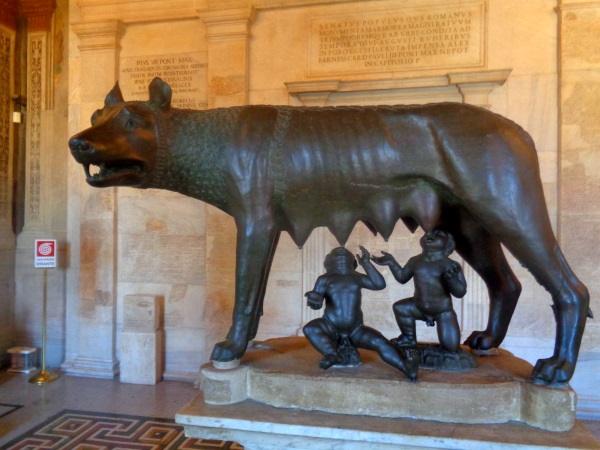Capitoline She-Wolf (Italian: Lupa capitolina, English: Capitoline She-Wolf): A key exhibit in the Capitoline Museum in Rome
The Capitoline She-Wolf, a timeless embodiment of legends and traditions, awaits you in Rome’s Capitoline Museums. Rooted in the mythological founding of Rome itself, this impressive sculpture takes tourists on a journey through the annals of history.

Origin and symbols
The focus of this fascinating sculpture is the myth of Romulus and Remus, the legendary twin founders of Rome. A she-wolf named Lupa holds her baby in her protective arms. It is a symbol of maternal care and the beginning of the city. Admire the intricate details, including the she-wolf’s furrowed eyebrows and the twins’ delicate limbs.
The Capitoline she-wolf dates back to the 5th century BC. BC and is evidence of the artistic skills of ancient sculptors. The creation of the statue is attributed to the Etruscan civilization, a pre-Roman civilization. Stand before this timeless masterpiece and contemplate the craftsmanship that has stood the test of time for millennia and provides a tangible link to Rome’s early artistic heritage.
Important for travelers to Rome: We have only ever seen queues in Europe that are hundreds of meters long or several hours long in Rome. This is especially true for St. Peter’s Basilica, the Colosseum and the Vatican Museums. Be sure to buy skip-the-line tickets online beforehand and skip the queue!: There are such tickets on this link
Discovery and History Capitoline She-Wolf
Embark on a journey through time and explore the discovery and subsequent history of the Capitoline Wolf. Excavated in the 15th century, the journey of this sculpture also includes its placement in the Capitoline Museums, where it serves as a beacon of Rome’s enduring cultural heritage. Follow the history of the statue through the chronicles of art and monument preservation.
Our 3 articles about the Capitoline Museum:
The Capitoline Museum all information for visitors and an overview
Marcus Aurelius equestrian statue
Meaning
In addition to its mythological significance, the Capitoline wolf has played an important role in Rome’s political and cultural identity. See how this statue was adopted as a symbol of the city, appearing on coins, coats of arms and other state symbols. Understand how these ancient sculptures continue to resonate in the modern consciousness and serve as powerful symbols of Roman identity.
Conservation and restoration
Gain insight into the meticulous conservation and restoration efforts that have ensured the longevity of this iconic sculpture. Learn about the challenges conservators face when it comes to preserving the integrity of ancient artifacts and striking a delicate balance between conservation and public accessibility.
At the end of our visit to the Capitoline Museums, the Capitoline She-Wolf stands not only as a statue, but also as a living testimony to the enduring power of myth and the indomitable Roman spirit. Take the opportunity to witness the fusion of ancient storytelling and artistic craftsmanship and let the Capitoline She-Wolf spark a deeper understanding of the mythical origins of the Eternal City.
Youtube videos on the topic
Legend of the founding of Rome
According to legend, Rome was founded by twin brothers Romulus and Remus, who were raised by a she-wolf. Although this story is not considered a historical record and part of Roman mythology, it influenced the formation of Rome’s identity and the founding myth.
According to legend, Romulus and Remus were the sons of Rhea Silvia, the goddess Vesta and the god Mars. The king of Alba Longa feared that the twins would overthrow him, so he ordered them to be left behind in the Tiber. The babies were left in a basket where a she-wolf found them and looked after them. Eventually they were discovered by a shepherd named Faustulus and raised in his home.
As the twins grew older, they decided to build a city near the place where they had been abandoned. However, there was no agreement on which hill it should be built on. According to legend, Romulus killed Remus in a fit of rage during the conflict, making him the sole founder of Rome. According to traditional dating, he founded in 753 BC. The city on the Palatine Hill.
The story of Romulus and Remus is a fascinating myth, but the historical origins of Rome are more complex. The city probably developed gradually through a process of settlement and assimilation of various Italian peoples. The actual founding of Rome is not a precise historical event, and the traditional date is 753 BC. BC is seen as more symbolic than accurate. Rome’s early history is a mix of mythological and historical elements, often making it difficult to distinguish fact from fiction.
Our tip: Buy tickets for Rome online in advanceFor some years now, there have been several large providers of tickets, entrance tickets, tours, etc. for your holiday You can buy entrance tickets for sights online in advance and save yourself queuing at the ticket office. You can also book bus tours, attractions, excursions and much more on the internet. We have picked out two good and reputable providers for you: 1. Getyourguide: Click here for Rome tickets 2. Tiqets: Click here for Rome tickets |